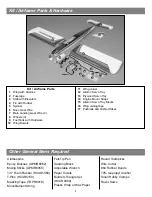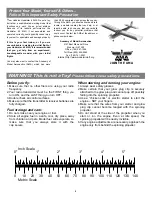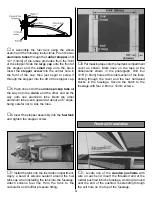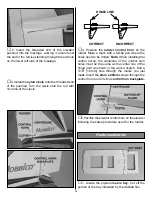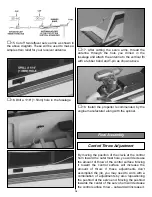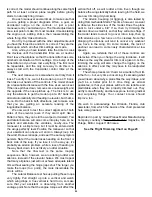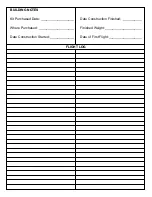
❏
7. Set the rudder and elevator so they are in the
neutral position as shown.
❏
8. With the elevator servo and the elevator both
in the neutral position, make a mark on the elevator
pushrod where the hole in the servo arm is. Make
a 90° bend at the mark on the pushrod. Insert the
pushrod into the hole in the servo arm and attach
a Great Planes FasLink
™
(GPMQ3820) to the
pushrod. Repeat this step for the rudder pushrod.
Should you decide to use some other installation
method, follow the manufacturer’s instructions.
❏
9. Locate a screw-lock pushrod connector, a
4-40 set screw and the nylon retainer. Install it on
the remaining arm on the rudder servo by first
sliding the nose gear steering pushrod through the
hole in the fitting and then assembling the screw-
lock pushrod connector as shown in the above
sketch. Set the nose wheel to be straight and then
tighten the 4-40 set screw onto the pushrod wire.
❏
10. Turn on the transmitter and receiver. Set the
throttle to full open. Install the pushrod into the
other screw-lock pushrod connector, then open the
carburetor on your engine to full open. Connect the
throttle linkage following the same steps as used
for the nose gear steering.
❏
11. Install the servo into the plywood servo tray
in the center of the wing. Use a 1/6" [1.5mm] drill to
pre-drill the holes for the servo mounting screws.
❏
12. Install the clevises on the threaded ends of
the pushrods by turning the clevis 14 times. Thread
the nylon torque rod horn onto the aileron torque
rod and then attach the clevis to the horn.
❏
13. Connect the aileron servo to the receiver
and center the aileron servo. Center the right
aileron, then align the pushrod to the servo arm.
Make a mark on the pushrod when it is in line with
the hole in the servo horn. Bend the wire 90
degrees on the mark you just made. After making
the bend in the pushrod, install it through the hole
in the servo horn and attach it with a Faslink.
❏
14. Follow the same procedure for the left aileron.
RETAINER
2-56 (.074")
Pushrod Wire
Servo Horn
FasLink
1/16"
15



